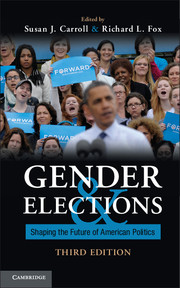Book contents
- Frontmatter
- Contents
- List of Figures, Text Boxes, and Photos
- List of Tables
- Contributors
- Acknowledgments
- Introduction
- 1 Presidential Elections
- 2 Cracking the “Highest, Hardest Glass Ceiling”
- 3 Voter Participation and Turnout
- 4 Voting Choices
- 5 Latinas and Electoral Politics
- 6 African-American Women and Electoral Politics
- 7 Congressional Elections
- 8 Political Parties and Women's Organizations
- 9 Advertising, Websites, and Media Coverage
- 10 Women's Election to Office in the Fifty States
- Index
- References
10 - Women's Election to Office in the Fifty States
Opportunities and Challenges
Published online by Cambridge University Press: 05 June 2014
- Frontmatter
- Contents
- List of Figures, Text Boxes, and Photos
- List of Tables
- Contributors
- Acknowledgments
- Introduction
- 1 Presidential Elections
- 2 Cracking the “Highest, Hardest Glass Ceiling”
- 3 Voter Participation and Turnout
- 4 Voting Choices
- 5 Latinas and Electoral Politics
- 6 African-American Women and Electoral Politics
- 7 Congressional Elections
- 8 Political Parties and Women's Organizations
- 9 Advertising, Websites, and Media Coverage
- 10 Women's Election to Office in the Fifty States
- Index
- References
Summary
During presidential election years, all eyes are focused on the top of the ticket. Congressional races attract attention, too, especially in years in which control of Congress could shift. In contrast, state elections are typically carried out with far less fanfare and attention from voters and the media. However, state elections deserve their turn in the spotlight.
State governments are critical to American politics and public policy. The fifty states are often at the forefront of policy innovations, earning them status as “laboratories” for testing out new ideas. For example, the national Family and Medical Leave Act (FMLA) was influenced by state policies, and today some state family leave and maternity leave policies are more generous than the national policy. Meanwhile, a state's experiences can provide warning to Congress and other states about policy directions that should be avoided.
Voters can influence policy choices through state elections. Who runs, wins, and serves matters because state policies are consequential, affecting people’s daily lives. The decisions that states make today can have effects over the long run, putting a state on a particular trajectory and foreclosing alternatives. Governors and state legislative leaders can also be agenda setters and opinion leaders in their states. Moreover, today’s state legislators and statewide officials are tomorrow’s candidates for governor, Congress, and president.
- Type
- Chapter
- Information
- Gender and ElectionsShaping the Future of American Politics, pp. 265 - 288Publisher: Cambridge University PressPrint publication year: 2013



